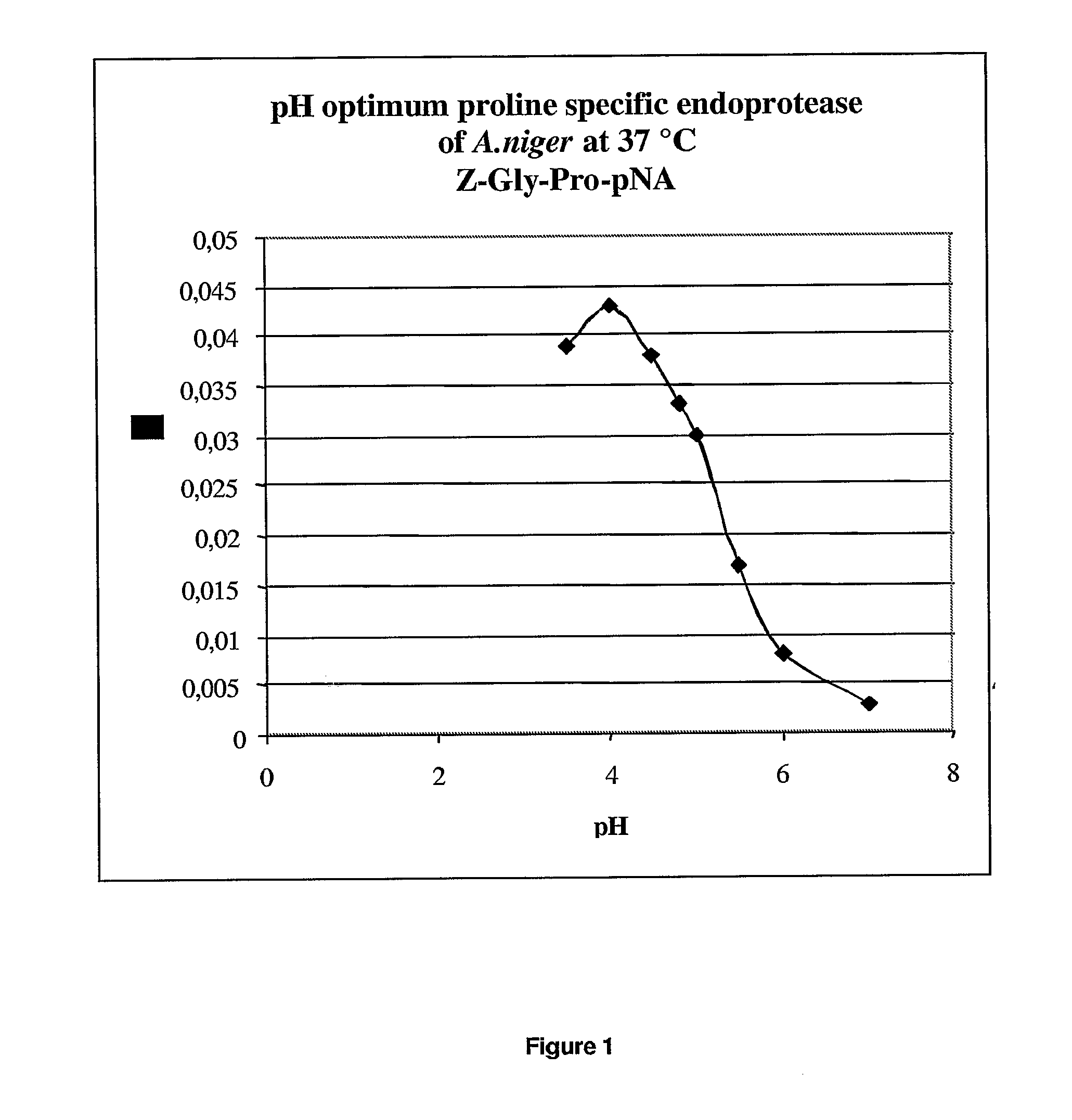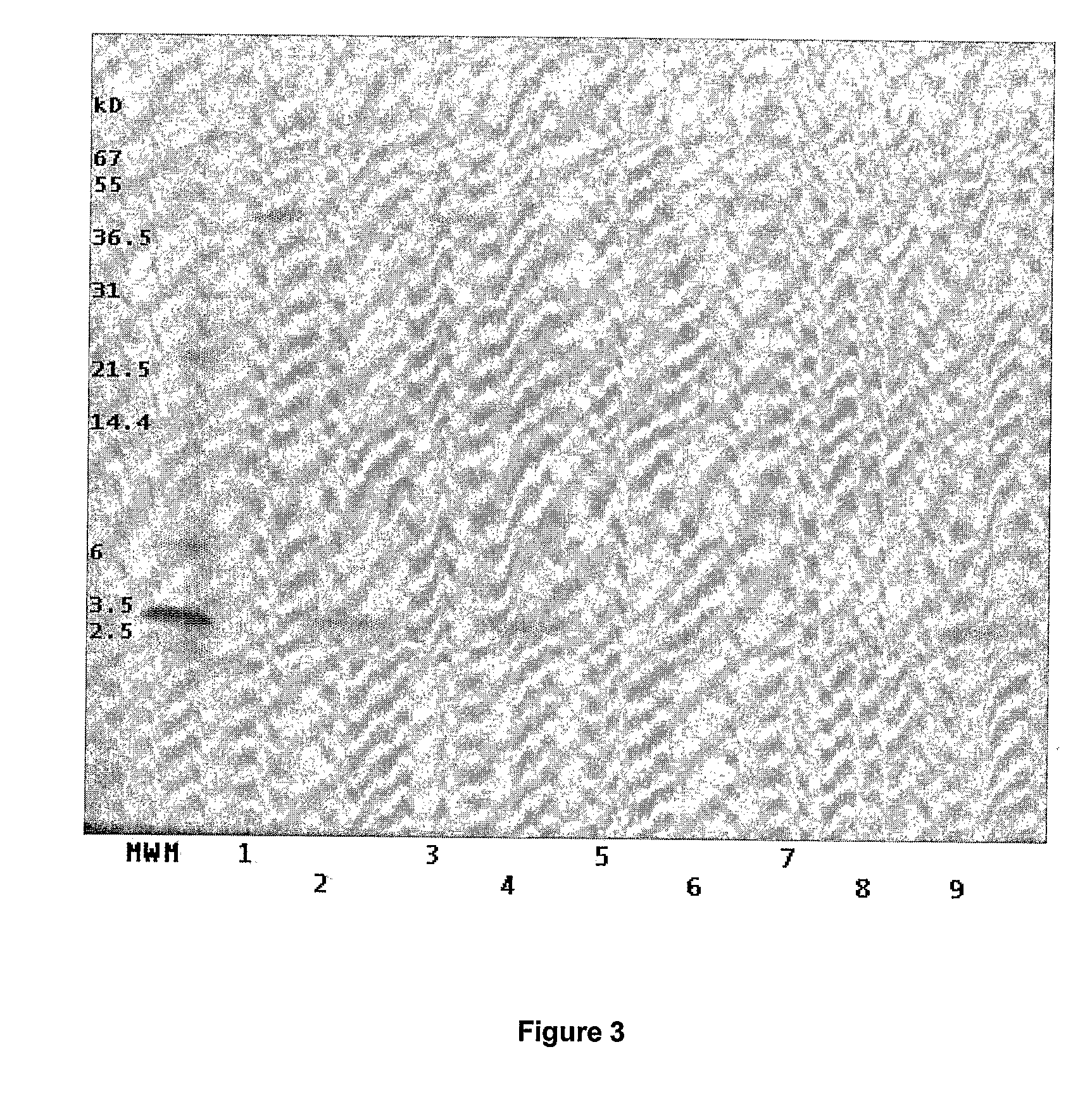Blood Pressure Lowering Oligopeptides
a technology of oligopeptides and blood pressure, which is applied in the direction of peptide/protein ingredients, drug compositions, metabolic disorders, etc., can solve the problems of lactic acid bacteria living organisms, difficult control of type and quantity of excreted enzymes, and prevalent risk factors for cardiovascular diseases, etc., to achieve positive effect on health, convenient incorporation into food products, and positive effect on an asp
- Summary
- Abstract
- Description
- Claims
- Application Information
AI Technical Summary
Benefits of technology
Problems solved by technology
Method used
Image
Examples
example 1
The Enzyme as Obtained from A. Niger Represents a New Class of Proline Specific Enzymes
[0143] From the entire coding sequence of the A. niger derived proline specific endoprotease as provided in WO 02 / 45524 a protein sequence of 526 amino acids can be determined. The novelty of the enzyme was confirmed by BLAST searches of databases such as SwissProt, PIR and trEMBL. To our surprise, no clear homology could be detected between the A. niger enzyme and the known prolyl oligopeptidases. Closer inspection of the amino acid sequence, however, revealed low but significant homology to Pro-X carboxypeptidases (EC3.4.16.2), dipeptidyl aminopeptidases I (EC3.4.14.2), and thymus specific serine protease. All of these enzymes have been assigned to family S28 of clan SC of serine peptidases (Handbook of Proteolytic Enzymes; Barrett A. J.; Rawlings N. D.; Woessner J. F., Eds.; Academic Press, London, UK, 1998, 369-415). Also the GxSYxG configuration around the active site serine is conserved bet...
example 2
The pH and Temperature Optima of the Proline Specific Endoprotease as Obtained from A. Niger
[0144] To establish the pH optimum of the A. niger derived proline specific endoprotease, buffers with different pH values were prepared. Buffers of pH 4.0-4.5-4.8-5.0-5.5 and 6.0 were made using 0.05 mol / l Na-acetate and 0.02 M CaCl2; buffers of pH 7.0 and 8.0 were made using 0.05 M Tris / HCl buffers containing 0.02 M CaCl2. The pH values were adjusted using acetic acid and HCl respectively. The chromogenic synthetic peptide Z-Gly-Pro-pNA was used as the substrate. The “pNA” (p-Nitroanilide) substrates cause color changes if the X-pNA peptide bond is cleaved. The buffer solution, the substrate solution and the prolyl endoprotease pre-dilution (in an activity of 0.1 U / mL), were heated to exactly 37.0° C. in a waterbath. After mixing the reaction was followed spectrophotometrically at 405 nm at 37.0° C. for 3.5 min, measuring every 0.5 min. From the results shown in FIG. 1 it is clear that the...
example 3
The Specificity of the A. Niger Derived Proline Specific Endoprotease
[0146] Crude as well as chromatographically purified enzyme samples as obtained from an A. niger strain containing multiple copies of the expression cassette (cf WO 02 / 45524) were tested against a collection of chromogenic peptide substrates to establish the specificity of the encoded endoprotease. The endoproteolytic activity of the enzyme was tested on an AAXpNA substrates in which “X” represents different natural amino acid residues.
[0147] Stock solutions of AAX-pNA substrates (150 mmol / l) were diluted 100× in 0.1M acetate buffer pH 4.0 containing 20 CaCl2. The 10 minutes kinetic measurements at 40 degrees C. in a TECAN Genios MTP Reader (Salzburg, Vienna) at 405 nm recorded the increases in optical density. The data generated were further processed in Excel to yield the picture shown in FIG. 2. From the result it is clear that the A. niger derived endoprotease is highly specific for prolyl peptide bonds with ...
PUM
| Property | Measurement | Unit |
|---|---|---|
| incubation time | aaaaa | aaaaa |
| incubation time | aaaaa | aaaaa |
| weight ratio | aaaaa | aaaaa |
Abstract
Description
Claims
Application Information
 Login to View More
Login to View More - R&D
- Intellectual Property
- Life Sciences
- Materials
- Tech Scout
- Unparalleled Data Quality
- Higher Quality Content
- 60% Fewer Hallucinations
Browse by: Latest US Patents, China's latest patents, Technical Efficacy Thesaurus, Application Domain, Technology Topic, Popular Technical Reports.
© 2025 PatSnap. All rights reserved.Legal|Privacy policy|Modern Slavery Act Transparency Statement|Sitemap|About US| Contact US: help@patsnap.com



